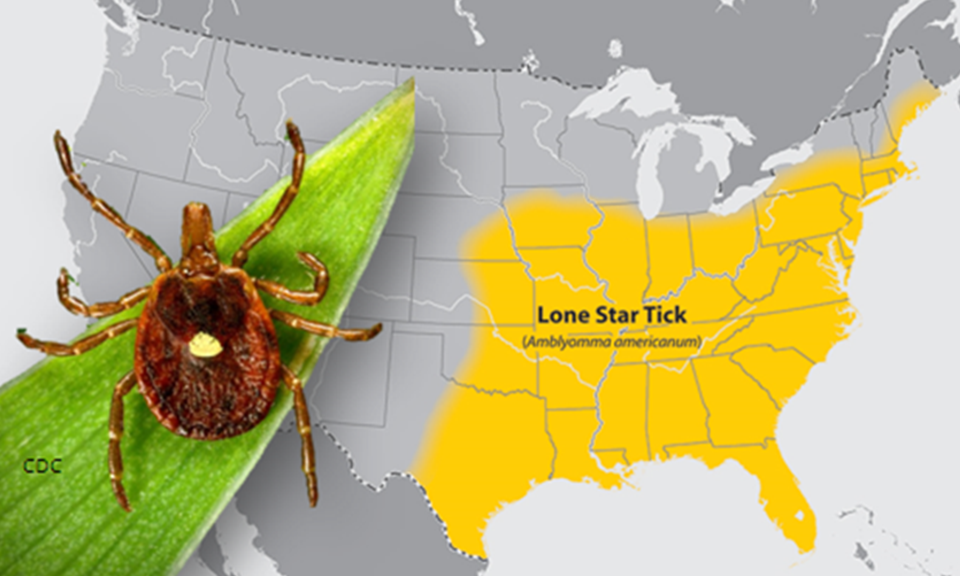Ticks in South Carolina
Ticks are external parasites that go through four developmental life stages: Egg, six-legged larva, eight-legged nymph, and adult. Ticks must attach and take a blood meal from animal hosts to grow and develop into the next life stage or to produce offspring. In South Carolina, people often encounter six tick species: the blacklegged, lone star, American dog, brown dog, Gulf Coast, and Asian longhorned ticks. Tick bites and tick-borne disease can occur year round. Ticks are generally found near the ground in forests and in areas with brush or tall grass and weeds. Ticks cannot jump or fly. Instead, they climb tall grasses or shrubs and wait for a potential host to brush against them. This behavior is known as “questing.” When this happens, they climb onto the host and seek a site for attachment.
Tick-Borne Diseases
Ticks can carry and transmit a multitude of pathogens that may result in contracting a tick-borne disease. Tickborne diseases transmitted by these ticks include anaplasmosis, babesiosis, Lyme disease, Rickettsia parkeri rickettsiosis, Rocky Mountain spotted fever, Southern Tick-Associated Rash Illness (STARI), ehrlichiosis, Powassan virus disease, Heartland virus, and tularemia. In addition to tick-borne diseases, a toxin can be transmitted through the saliva of a tick bite that causes progressive paralysis, a condition known as “tick paralysis.” Tick feeding also may result in mild to severe allergic reactions in some individuals.
Tick Bite Prevention
Attached ticks should be removed as soon as possible to prevent the transmission of possible pathogens. Disease transmission from ticks generally occurs within 24 hours or up to 72 hours after attachment, but diseases such as Powassan virus disease can be transmitted in as little as 15 minutes. In general, the longer a tick is attached, the more likely it is to pass on an infection if it is carrying one. Below are some general precautions that if used or performed properly can help prevent tick bites:
- Use Environmental Protection Agency (EPA)-registered insect repellents containing DEET, picaridin, IR3535, oil of lemon eucalyptus, para-menthane-diol, or 2-undecanone. Treat clothing and gear, such as boots, pants, socks, and tents with products containing 0.5% permethrin. Additional repellent options are available. EPA’s repellent search tool can help find the product that best suits your needs. Follow label directions.
- Wear protective clothing tucked in around the ankles and waist.
- Shower with soap and shampoo soon after being outdoors to reduce the possibility of tick attachment.
- Keep weeds and tall grass cut and avoid tick-infested places such as grassy and marshy woodland areas when possible.
- Stay in the center of paths when hiking or walking through woods.
- Check for ticks daily, especially under the arms, in and around the ears, inside the belly button, behind the knees, between the legs, around the waist, and on the hairline and scalp.
- Check pets for ticks daily. Treat dogs and cats for ticks as recommended by a veterinarian.
- Learn more about landscaping techniques that can help reduce blacklegged tick populations in the yard.
Tick Removal

- Never squeeze ticks or use heat, solvents, nail polish, petroleum jelly, or other material to make the tick detach from the skin. These actions often cause the tick to regurgitate fluids into the bite, increasing potential for disease transmission.
- Use fine-tipped tweezers to remove attached ticks by grasping the tick as close to the skin’s surface as possible.
- Pull upward with steady, even pressure while being careful not to jerk or twist the tick as this could cause the mouthparts to break off and remain in the skin.
- After removal, clean the bite area with soap and water and apply an antiseptic such as iodine, hydrogen peroxide, or rubbing alcohol.
- Write down the date of the tick bite to help monitor for potential symptoms.
Tick Surveillance in South Carolina – You Can Help
With an increase in tick species and tick-borne disease awareness in South Carolina, the SC DHEC Vector-Borne Diseases Lab is partnering with the University of South Carolina and Clemson University Livestock and Poultry Health to collect ticks from people, domestic animals, and livestock. This surveillance will help determine tick species presence, prevalence, distribution, seasonality, and potential tick-borne disease risks. The USC Laboratory of Vector-borne and Zoonotic Diseases Lab staff will only provide pathogen results if they are requested, but reporting results is not the standard procedure to accommodate the variance in submission times and subsequent laboratory processing delays (i.e., ticks are processed in batches). Additionally, all ticks received might not be tested or might not be tested for all pathogens due to funding restraints. Accordingly, test results from ticks that were attached to people should not be used to inform treatment decisions.
To participate in the tick surveillance project, send collected ticks in any sealable vial or zippered storage bag to:
The Laboratory of Vector-borne and Zoonotic Diseases
915 Greene Street #327
Columbia, SC 29201
OR
SC Department of Health and Environmental Control
ATTN: Vector-Borne Diseases Lab
8231 Parklane Rd BLDG 5
Columbia, SC 29223-4903
Please fill out the Passive Tick Submission form including:
- Your contact information
- Address of where the tick was collected (if not a street address, provide directions and distances from nearby road intersections)
- Date of collection
- Type of animal (or human) on which the tick was found
SC Ticks of Human Concern

Black Legged Tick
*Image courtesy of the Center for Disease Control and Prevention

Lone Star Tick
*Image courtesy of the Center for Disease Control and Prevention

American Dog Tick
*Image courtesy of the Center for Disease Control and Prevention

Brown Dog Tick
*Image courtesy of the Center for Disease Control and Prevention

Gulf Coast Tick
*Image courtesy of the Center for Disease Control and Prevention

Asian Longhorned Tick
*Beard et al. 2018. Multistate Infestation with the Exotic Disease-Vector Tick Haemaphysalis longicornis – United States, August 2017-September 2018. MMWR 67:1310-1313